Author: Alfred, Duoduo
1. What is intent?
Since Paradigm explained the concept of intent in "Intent-Based Architectures and Their Risks" released on June 1, 2023, "Intent-Centric" has become an important concept and development direction of Web3.
1. Definition of intent
In Paradigm's definition, "intent is a set of signed declarative constraints that allow users to outsource transaction creation to third parties without giving up full control over the transaction parties." Simply put, intent is goal-oriented, weakening or ignoring the implementation process. For example, I want D and am willing to pay A as the cost, without the need to perform the A-B-C-D process operation, and the intermediate links are outsourced to a third party. In abstract terms, intent-centered is the declarative paradigm, while Web3's previous transactions or operations are mostly imperative paradigms.
2. The significance of intent-centeredness: Web3's "1995 Moment"
The early development of computers began in the era of the imperative paradigm, which required users to interact and operate through command lines, which put forward high professional requirements for the use of computers and restricted the development of large-scale applications and technology. However, with the release of Windows 95, graphical user interfaces and browsers were introduced into computer operating systems, greatly lowering the user threshold and developing computer users from less than 50,000 to hundreds of millions. This moment of change is called the "1995 moment" of the Internet. It marks a fundamental change in the user interface, allowing ordinary people to easily access and use the Internet.

Similarly, with the development and maturity of Web2, many intent-centric products have become commonplace for users. For example, when taking a Didi taxi, the user's intention is to "get from point A to point B", and how to match drivers, optimize routes, settle fees, and provide information for both parties are all implemented by the platform. However, in the current Web3, users still face complexity in interactive operations, such as the series of steps involved in purchasing an NFT. If you have an intent-centric product, user operations will be greatly simplified.
In the Web3 world, by introducing more intuitive and user-friendly interfaces and operation processes, we can expect a breakthrough similar to the "Internet 1995 Moment", thereby promoting hundreds of millions of new users to easily access and use Web3, and further promoting large-scale technology adoption and industry development. This change will greatly promote the popularization and development of the Web3 ecosystem, making blockchain technology closer to the daily use of ordinary users, thereby achieving widespread acceptance and application of technology.
3. Key points for realizing intentions
(1) Focus on results rather than processes
Intent projects should allow users to clarify the intentions of transactions and operations through declarations, rather than specific execution steps.
(2) Execution delegation
Intent projects provide a mechanism that allows users to delegate the execution of intentions to the system, smart contracts or third-party service providers. Whether it is automatic or manual execution, the execution process should be consistent with the user's original intention and be able to provide sufficient flexibility and optimization space where appropriate.
(3) Verifiable results
In the blockchain world, the intent project ensures that the results of a transaction or operation are verifiable and traceable, so that users and related parties can clearly understand and verify the execution of the intent and ensure that the final result meets the user's expectations.
II. Overview of dappOS Fundamentals
1. Introduction to dappOS
dappOS is an intent execution network that creates a two-way market to convert intent into on-chain results: on the supply side, service providers pledge collateral and choose to run one or more execution services. On the demand side, it enables developers to find solutions that meet user intent.
2. dappOS underlying mechanism: Optimistic Minimum Stake OMS
In terms of the underlying network mechanism, dappOS introduced the Optimistic Minimum Staking OMS, which requires that each task be associated with a predefined value and potential compensation in case of failure, allowing tasks to be executed before the results are verified. If a task fails, the network punishes the responsible service provider through a consensus process to ensure that either the task submitted by the user is successfully executed or the user receives pre-specified compensation, which significantly improves the efficiency and versatility of the network.
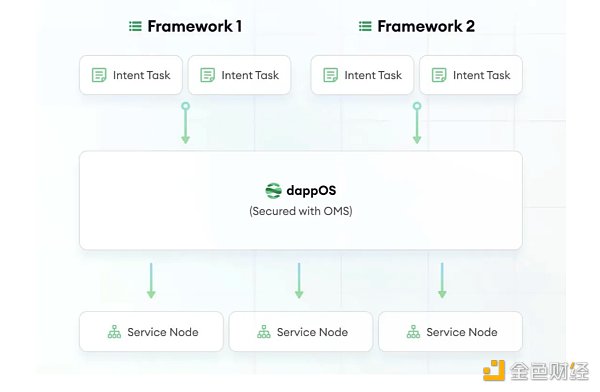
The OMS of dappOS and the AVS of EigenLayer have certain similarities in technical structure. The Service provider of dappOS is similar to the Operator in Eigenlayer. The main difference is that Eigenlayer focuses on general scenarios, such as DA, oracle, ZK processor, etc.; dappOS is more oriented to intent-centric task-related scenarios, and stipulates that each intent has a certain liquidation value, so that as long as the stake exceeds the liquidation value, the system is safe and efficient.
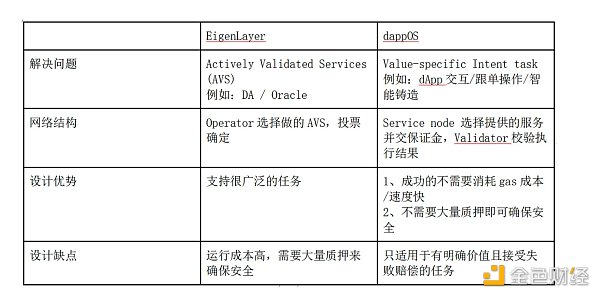
3. Application scenarios of dappOS
Currently, dappOS has many application scenarios, for example:
(1) Unified account
dappOS has a unified account compatible with the intent execution network. Similar to centralized exchanges, the assets therein can be used in any dApp on the integrated chain, and most mainstream tokens can be used to pay fees. That is, when the user's assets are distributed on various blockchains, the user can still achieve simultaneous control of accounts on different chains by signing.
At the same time, the dappOS unified account realizes a flexible external interaction method. Any application that can interact with an external owned account (EOA) can also interact through the unified account using a highly scalable execution interface and custom service logic.
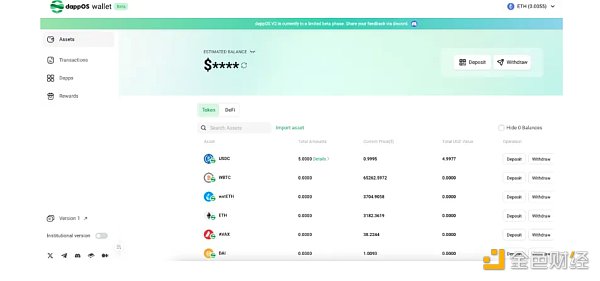
(2) Intent assets
The intent assets launched by dappOS will enable seamless use of different forms of assets in different scenarios. For example, dappOS will issue intentUSD as the intent asset of the US dollar stablecoin. It can be used as USDT when the user needs to use USDT, and as USDC when USDC is needed, and automatically earns income when it is idle in the account. This type of asset solves the biggest scenario problem of stablecoins and LSD assets, and makes it unnecessary for new users to understand the difference between homogeneous assets such as USDC/USDT. In simple terms, dappOS's intent assets can become the "Yu'ebao" in Web3. It uses the dappOS intent execution network to handle the complex details behind it, which will further improve the efficiency of digital assets and lower the threshold for use. (3) Real-time dApp contract interaction The dappOS intent execution network provides an excellent execution framework for real-time interaction with dApps. The framework allows users to achieve seamless transition from the initial state to the final state with a simple signature. The traditional implementation process of many intentions includes many on-chain operations such as cross-chain, asset conversion, and authorized contracts. These operations are essentially means rather than the user's purpose. The real-time interactive execution framework of dappOS allows users to directly achieve their purpose with one signature without having to worry about these intermediate operations, thereby optimizing the user experience.
In addition, through the design of mechanisms such as OMS, the real-time dapp interaction provided by dappOS can also ensure that all operations in the entire process meet the decentralization and security standards of the blockchain, while also ensuring the efficiency and low cost of the operation. This method of simplifying complex blockchain operations based on user intentions not only greatly improves user convenience, but also promotes the application and development of a wider range of blockchain technologies.
3. Advantages of dappOS
(1) Innovative underlying mechanism design
As the infrastructure of the intention track, the underlying mechanism of dappOS, OMS, is carefully designed for intention scenarios. This mechanism greatly improves the execution efficiency of intention tasks while ensuring user security. It can be said that the importance of dappOS's OMS to the intent track is equivalent to the importance of Eigenlayer's AVS to the Restaking track. Such an underlying mechanism enables dappOS to occupy the core ecological position of the intent track infrastructure.
(2) Rich application scenarios and first-mover advantage
The intent execution network of dappOS currently has many application scenarios, including unified accounts, intent assets, real-time dApp interactions, etc., which are rare in the intent track that is still in the potential explosion period. Compared with many other infrastructure projects in the intent track that are still in the concept and development stage, these application scenarios enable dappOS to cooperate with many current Web3 projects, expand its own ecological network and iterate one step ahead, form a first-mover advantage, and become the leader in the infrastructure of the intent track.
Three, dappOS ecological development
Since the second half of 2023, the dappOS ecosystem has begun to accelerate development. Since intent-centric interactions are easier for users to get started with, integrating dappos intent infrastructure can often bring considerable growth to projects. Therefore, many leading and emerging projects have cooperated with dappOS, such as Manta, GMX, BENQI, KiloEx, etc.
For example, after KiloEx integrated dappOS on April 16, 2024, the transaction volume increased by 217% in one week and the DAU increased by 3000%.
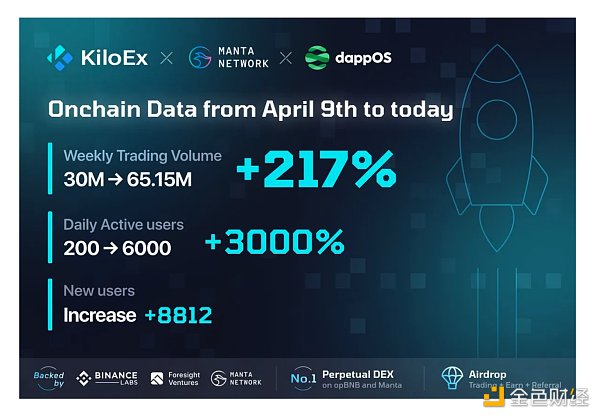
Fourth, financing information
dappOS has an excellent financing lineup and has received support from first-tier investment institutions including Polychain, Binance Labs, Sequoia, IDG, and Hashkey. Polychain, the lead investor in the A round, has made strong investment performance in this round of cycle and has invested in EigenLayer, the leader in re-staking, and Celestia, the leader in modularization. Dappos is a project that it intends to lay out in the track.
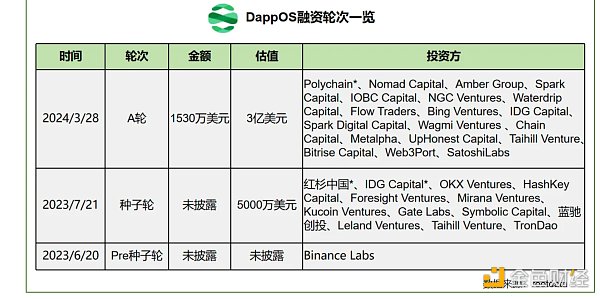
V. Conclusion
With the development of the underlying technology of blockchain and the gradual maturity of various projects, the future development will shift from infrastructure-oriented to application and user-friendly, and intention-centered projects will become the focus of the entire industry. dappOS has solid underlying technology, and this round of excellent investment institutions such as Polychain and Binance Labs have resource support, and there are also expanding head projects (such as GMX) joining the ecosystem. In the future, Dappos may become the next leader in the intention track, opening the moment of introducing large-scale applications and traffic.
 JinseFinance
JinseFinance






